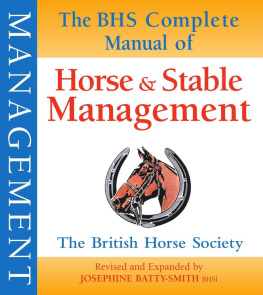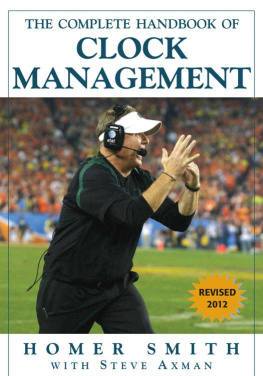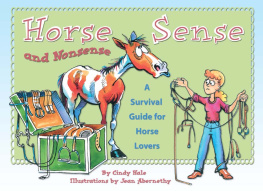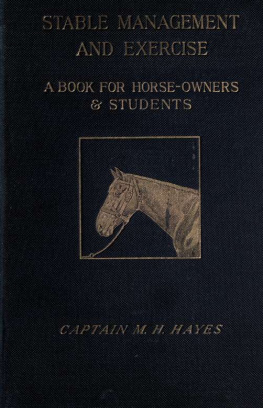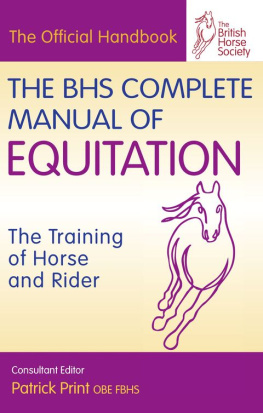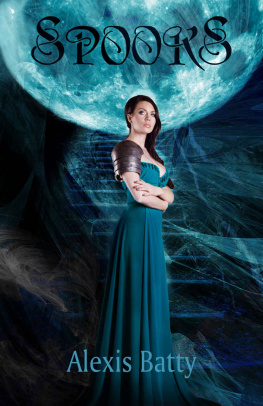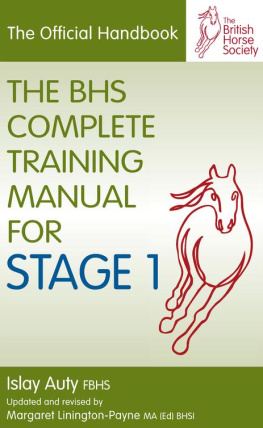The aim of this volume is to provide a reliable source of information and advice on all practical aspects of horse and stable management. Throughout the book emphasis is placed on the adoption of correct and safe procedures for the welfare of all who come into contact with horses, as well as for the animals themselves. The book has been compiled by a panel of experts, each drawing on considerable experience and contributing specialised knowledge on his or her chosen subject.
There is no one BHS method or procedure for doing any task. Any procedure that is safe for both handler and equine, is practical and efficient and achieves the right outcome is acceptable practice.
The British Horse Society would like to acknowledge the contribution made by the late Pat Smallwood FBHS, who undertook much of the initial work on this project.
The British Horse Society is also grateful to the following individuals for their invaluable assistance:
Joan Allen; Islay Auty FBHS; Goran Breisner FBHS; Carole Broad FBHS; Jo Claridge; Dr James L. Duncan; Eric Ellis; Sidney Free; Judy Harvey FBHS; Stewart Hastie MRCVS; Jeremy Houghton-Brown BPhilEd; Jane Kidd; Elizabeth Launder MSc; James Lord; Deborah Lucas MSc; Gillian McCarthy BSc; Jane McHugh; Dr David Marlin; Tessa Martin-Bird FBHS; Stella Hore; Clive Scott; Richard Shepherd; the late Michael Simons MRCVS; Barbara Slane Fleming FBHS; Sue Tanzer; Claire Tomlinson; Gillian Watson FBHS; Helen Webber FBHS; and members of the 1997 BHS Training Committee.
Illustrations
The line drawings are all by Dianne Breeze, except for the foot detail diagrams on pages 15 and 102 (left), which are by Christine Bousfield.
NOTE: Throughout the book the term horses is used and it will often include ponies.
The conformation of a horse or pony affects his soundness, ability to perform and comfort as a ride. If the horse is in good condition, the following features should be sought:
General Impression
The general impression should be that he is built in proportion, with all sectors matching and his outlook is alert, bold and confident.
The top line the neck, withers, back, loins and dock should form a succession of well-developed outlines, each of which blends smoothly into the next. He should have a good sloping shoulder, a relatively short back and a long croup, i.e. length from hip to point of buttock, giving an appearance of standing over a lot of ground, whilst being well balanced over his legs, which are four square underneath him.
If the horse is in poor condition, only an experienced person with a good eye can assess his potential. It takes skill to recognise whether he has the right make and shape; and to see that when given suitable care, food and work, he will make up into a worthwhile or even top-class animal.
Similarly, too much fat can disguise a horses outline, and can make it difficult to visualise what he will be like when the excess weight is lost and he is fit.
A horse with good skeletal structure, but poor muscle development, can be transformed by being given suitable work and the opportunity to use and develop his muscles in the correct way.
Feet
The much-quoted saying no foot, no horse is very true. The make and shape of feet are vital to the soundness and functioning of the horse.
Front feet and hind feet should be matching pairs. Any obvious difference in outline, angle of foot to the ground, or size of frog, should be viewed with suspicion. The only exception is the horse whose foot has been worn down through losing a shoe.
- The front feet should slope at an angle of 4550 from the ground.
- The hoof wall should continue at the same angle as the pastern when viewed from the side.
- The hind feet should have a slightly steeper slope, and should be longer and narrower than the front feet.
- All feet should point straight forwards. Any deviation from this is usually caused by poor conformation of the leg, and will result in faulty action.
The heels should be wide, with a well-developed frog to help absorb concussion. The sole should be slightly concave. Contracted heels and poorly developed frogs restrict the blood supply to the foot, and increase the vulnerability to navicular disease.
Large, flat feet can cause problems, particularly on stony ground. They are liable to develop corns and are easily bruised.
Small feet are a disadvantage, as they give a smaller weight-bearing surface, and there is a greater tendency towards unsoundness in the foot.

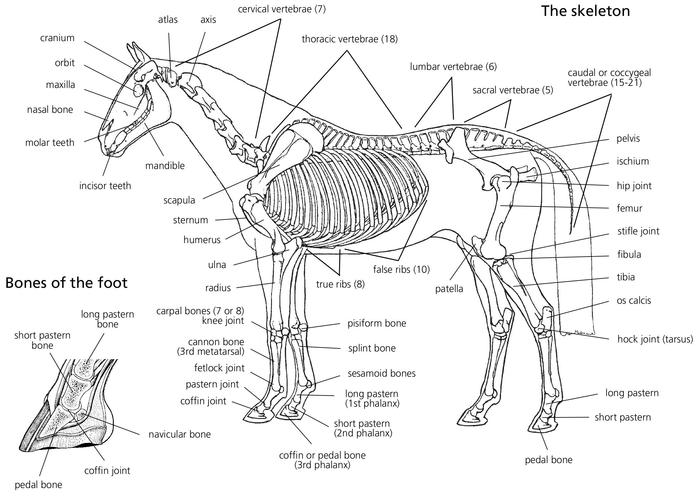
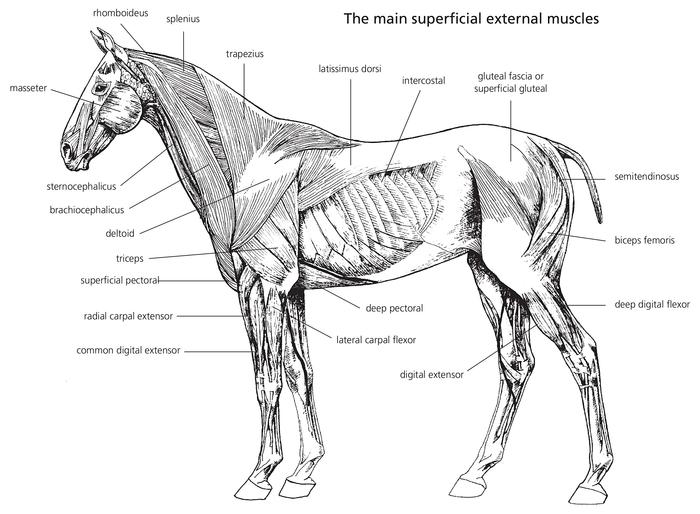
Simple Facts About the Superficial Muscles
Body muscles are responsible for maintaining posture and preserving the overall shape of the horse when he is standing still.
Some muscles limit movement and provide joint stability by preventing too much movement or preventing unwanted movement.
Muscles can only work in contraction, so are always arranged in opposing groups performing opposing actions.
Muscles must be attached at each end in order to produce their required action. They are attached at either end by tendons which are formed from dense white fibrous tissue. Each tendon is continuous with the belly of the muscle at one end and attaches seamlessly to the periosteum of the bone at the other.
There are different types of muscles to perform different tasks.
Muscles that cause a joint to bend are called flexors.
Muscles that cause a joint to straighten are called extensors.
A muscle which carries a limb further away from the body than it was previously is called an abductor.
The opposite action is produced by an adductor muscle.
Some of the Major Superficial Muscles and Their Actions
Brachiocephalic: extending from the front of the upper arm to the head. When the horse is standing still this muscle helps to swing the head and neck to the side. During movement it draws the forelimb forwards when the foot is raised from the ground at the end of the stride.
Trapezius: the muscle on either side of the withers, over the top of the Rhomboideus and Splenius muscles. It draws the scapula up and back.
Rhomboideus: draws the scapula upwards and forwards; it elevates the shoulder.
Splenius: elevates the head and turns the head and neck to one side.
Latissimus dorsi: runs from shoulder blade to back. It draws the scapula down and back. It draws the humerus up and back and supports the dorsal part of the thorax.
Longissimus dorsi: runs along the back. The muscle the rider sits upon. It supports the riders weight.
Sternocephalicus: flexes the head and neck forwards and downwards.
Serratus ventralis: the cervical and thoracic part acts as a sling for the trunk.
Triceps: extensor muscle of the elbow.
Biceps: flexor muscle of the elbow.
Semitendinosus: extends hip and flexes the stifle.

